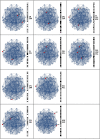Modelling brain dynamics by Boolean networks
- PMID: 36192582
- PMCID: PMC9529940
- DOI: 10.1038/s41598-022-20979-x
Modelling brain dynamics by Boolean networks
Abstract
Understanding the relationship between brain architecture and brain function is a central issue in neuroscience. We modeled realistic spatio-temporal patterns of brain activity on a human connectome with a Boolean networks model with the aim of computationally replicating certain cognitive functions as they emerge from the standardization of many fMRI studies, identified as patterns of human brain activity. Results from the analysis of simulation data, carried out for different parameters and initial conditions identified many possible paths in the space of parameters of these network models, with normal (ordered asymptotically constant patterns), chaotic (oscillating or disordered) but also highly organized configurations, with countless spatial-temporal patterns. We interpreted these results as routes to chaos, permanence of the systems in regimes of complexity, and ordered stationary behavior, associating these dynamics to cognitive processes. The most important result of this work is the study of emergent neural circuits, i.e., configurations of areas that synchronize over time, both locally and globally, determining the emergence of computational analogues of cognitive processes, which may or may not be similar to the functioning of biological brain. Furthermore, results put in evidence the creation of how the brain creates structures of remote communication. These structures have hierarchical organization, where each level allows for the emergence of brain organizations which behave at the next superior level. Taken together these results allow the interplay of dynamical and topological roots of the multifaceted brain dynamics to be understood.
© 2022. The Author(s).
Conflict of interest statement
The authors declare no competing interests.
Figures















Similar articles
-
Spatio-temporal modeling of connectome-scale brain network interactions via time-evolving graphs.Neuroimage. 2018 Oct 15;180(Pt B):350-369. doi: 10.1016/j.neuroimage.2017.10.067. Epub 2017 Nov 10. Neuroimage. 2018. PMID: 29102809 Free PMC article. Review.
-
[Dynamic paradigm in psychopathology: "chaos theory", from physics to psychiatry].Encephale. 2001 May-Jun;27(3):260-8. Encephale. 2001. PMID: 11488256 French.
-
Modeling spatio-temporal patterns of holistic functional brain networks via multi-head guided attention graph neural networks (Multi-Head GAGNNs).Med Image Anal. 2022 Aug;80:102518. doi: 10.1016/j.media.2022.102518. Epub 2022 Jun 15. Med Image Anal. 2022. PMID: 35749981
-
Estimation of Directed Effective Connectivity from fMRI Functional Connectivity Hints at Asymmetries of Cortical Connectome.PLoS Comput Biol. 2016 Mar 16;12(3):e1004762. doi: 10.1371/journal.pcbi.1004762. eCollection 2016 Mar. PLoS Comput Biol. 2016. PMID: 26982185 Free PMC article.
-
Is there chaos in the brain? II. Experimental evidence and related models.C R Biol. 2003 Sep;326(9):787-840. doi: 10.1016/j.crvi.2003.09.011. C R Biol. 2003. PMID: 14694754 Review.
Cited by
-
A social robot connected with chatGPT to improve cognitive functioning in ASD subjects.Front Psychol. 2023 Oct 5;14:1232177. doi: 10.3389/fpsyg.2023.1232177. eCollection 2023. Front Psychol. 2023. PMID: 37868599 Free PMC article.
-
How the dynamic interplay of cortico-basal ganglia-thalamic pathways shapes the time course of deliberation and commitment.bioRxiv [Preprint]. 2025 Mar 17:2025.03.17.643668. doi: 10.1101/2025.03.17.643668. bioRxiv. 2025. PMID: 40166196 Free PMC article. Preprint.
-
Review of the Brain's Behaviour after Injury and Disease for Its Application in an Agent-Based Model (ABM).Biomimetics (Basel). 2024 Jun 14;9(6):362. doi: 10.3390/biomimetics9060362. Biomimetics (Basel). 2024. PMID: 38921242 Free PMC article. Review.
-
Connectome-based prediction of functional impairment in experimental stroke models.PLoS One. 2024 Dec 19;19(12):e0310743. doi: 10.1371/journal.pone.0310743. eCollection 2024. PLoS One. 2024. PMID: 39700116 Free PMC article.
References
-
- Jirsa, V. K. Handbook of Brain Connectivity, vol. 321 (ed. A. R. McIntosh) (Springer, 2013). ISBN: 978-3-540-71512-2.
MeSH terms
LinkOut - more resources
Full Text Sources

